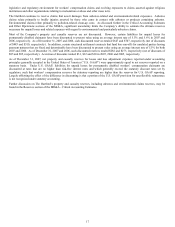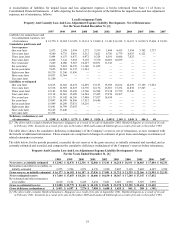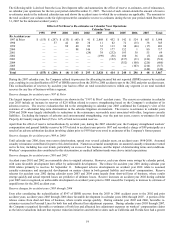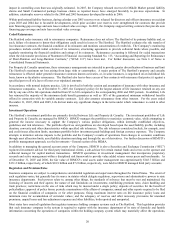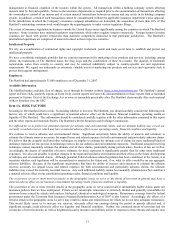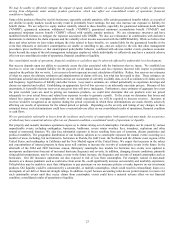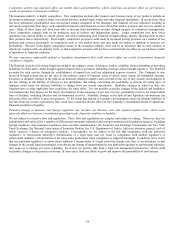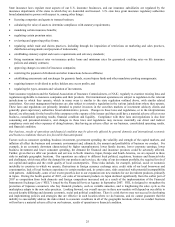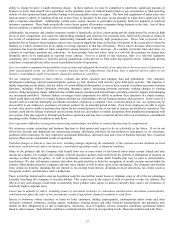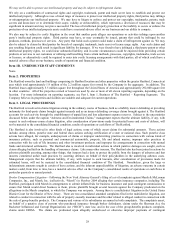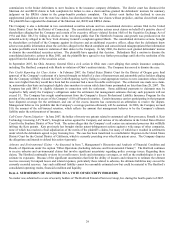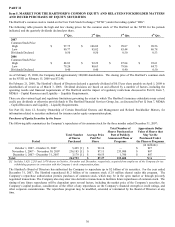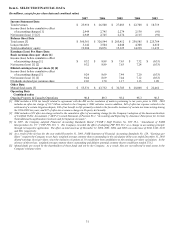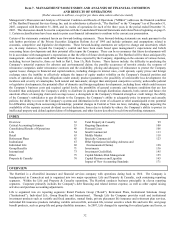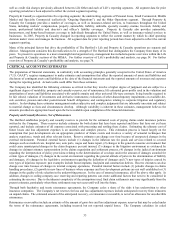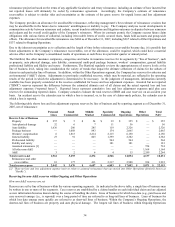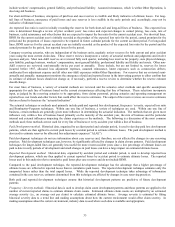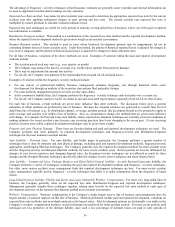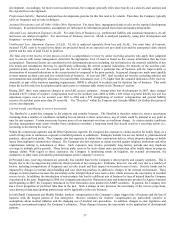The Hartford 2007 Annual Report Download - page 27
Download and view the complete annual report
Please find page 27 of the 2007 The Hartford annual report below. You can navigate through the pages in the report by either clicking on the pages listed below, or by using the keyword search tool below to find specific information within the annual report.27
ability to charge the price it might otherwise charge. In these markets, we may be compelled to underwrite significant amounts of
business at lower than desired rates, participate in the operating losses of residual market plans or pay assessments to fund operating
deficits of state-sponsored funds, possibly leading to an unacceptable returns on equity. The laws and regulations of many states also
limit an insurer’ s ability to withdraw from one or more lines of insurance in the state, except pursuant to a plan that is approved by the
state’ s insurance department. Additionally, certain states require insurers to participate in guaranty funds for impaired or insolvent
insurance companies. These funds periodically assess losses against all insurance companies doing business in the state. Any of these
factors could have a material adverse effect on our consolidated results of operations.
Additionally, the property and casualty insurance market is historically cyclical, experiencing periods characterized by relatively high
levels of price competition, less restrictive underwriting standards and relatively low premium rates, followed by periods of relatively
low levels of competition, more selective underwriting standards and relatively high premium rates. Prices tend to increase for a
particular line of business when insurance carriers have incurred significant losses in that line of business in the recent past or when the
industry as a whole commits less of its capital to writing exposures in that line of business. Prices tend to decrease when recent loss
experience has been favorable or when competition among insurance carriers increases. In a number of product lines and states, we
continue to experience premium rate reductions. In these product lines and states, there is a risk that the premium we charge may
ultimately prove to be inadequate as reported losses emerge. Even in a period of rate increases, there is a risk that regulatory
constraints, price competition or incorrect pricing assumptions could prevent us from achieving targeted returns. Inadequate pricing
could have a material adverse effect on our consolidated results of operations.
If we are unable to maintain the availability of our systems and safeguard the security of our data due to the occurrence of disasters or
other unanticipated events, our ability to conduct business may be compromised, which may have a material adverse effect on our
business, consolidated results of operations, financial condition or cash flows.
We use computer systems to store, retrieve, evaluate and utilize customer and company data and information. Our computer,
information technology and telecommunications systems, in turn, interface with and rely upon third-party systems. Our business is
highly dependent on our ability, and the ability of certain affiliated third parties, to access these systems to perform necessary business
functions, including, without limitation, providing insurance quotes, processing premium payments, making changes to existing
policies, filing and paying claims, administering variable annuity products and mutual funds, providing customer support and managing
our investment portfolios. Systems failures or outages could compromise our ability to perform these functions in a timely manner,
which could harm our ability to conduct business and hurt our relationships with our business partners and customers. In the event of a
disaster such as a natural catastrophe, an industrial accident, a blackout, a computer virus, a terrorist attack or war, our systems may be
inaccessible to our employees, customers or business partners for an extended period of time. Even if our employees are able to report
to work, they may be unable to perform their duties for an extended period of time if our data or systems are disabled or destroyed. Our
systems could also be subject to physical and electronic break-ins, and subject to similar disruptions from unauthorized tampering with
our systems. This may impede or interrupt our business operations and may have a material adverse effect on our business, consolidated
operating results, financial condition or cash flows.
If we experience difficulties arising from outsourcing relationships, our ability to conduct business may be compromised.
We outsource certain technology and business functions to third parties and expect to do so selectively in the future. If we do not
effectively develop and implement our outsourcing strategy, third-party providers do not perform as anticipated, or we experience
problems with a transition, we may experience operational difficulties, increased costs and a loss of business that may have a material
adverse effect on our consolidated results of operations.
Potential changes in federal or state tax laws, including changes impacting the availability of the separate account dividend received
deduction, could adversely affect our business, consolidated operating results or financial condition.
Many of the products that the Company sells benefit from one or more forms of tax-favored status under current federal and state
income tax regimes. For example, the Company sells life insurance policies that benefit from the deferral or elimination of taxation on
earnings accrued under the policy, as well as permanent exclusion of certain death benefits that may be paid to policyholders’
beneficiaries. We also sell annuity contracts that allow the policyholders to defer the recognition of taxable income earned within the
contract. Other products that the Company sells also enjoy similar, as well as other, types of tax advantages. The Company also benefits
from certain tax benefits, including but not limited to, tax-exempt bond interest, dividends-received deductions, tax credits (such as
foreign tax credits), and insurance reserve deductions.
There is risk that federal and/or state tax legislation could be enacted that would lessen or eliminate some or all of the tax advantages
currently benefiting the Company or its policyholders. This could occur in the context of deficit reduction or other tax reforms. The
effects of any such changes could result in materially lower product sales, lapses of policies currently held, and/or our incurrence of
materially higher corporate taxes.
Losses due to defaults by others, including issuers of investment securities or reinsurance and derivative instrument counterparties,
could adversely affect the value of our investments, results of operations, financial condition or cash flows.
Issuers or borrowers whose securities or loans we hold, customers, trading counterparties, counterparties under swaps and other
derivative contracts, reinsurers, clearing agents, exchanges, clearing houses and other financial intermediaries and guarantors may
default on their obligations to us due to bankruptcy, insolvency, lack of liquidity, adverse economic conditions, operational failure,
fraud or other reasons. Such defaults could have a material adverse effect on our operating results, financial condition and cash flows.


